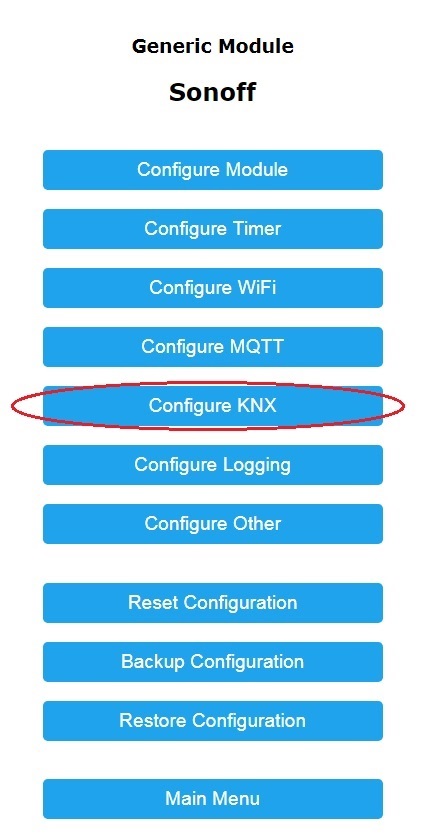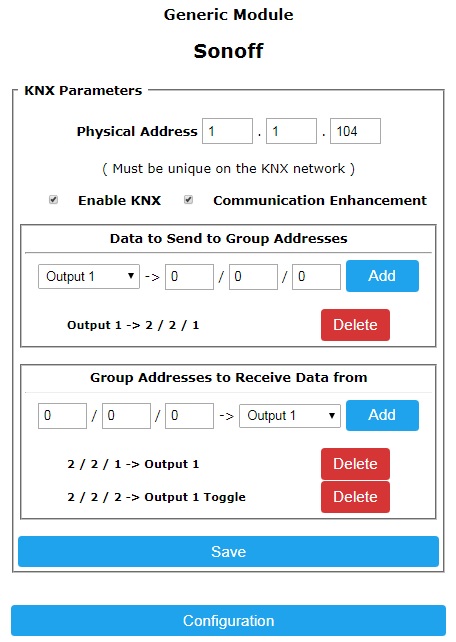KNX
This feature is included in ESP32 builds, but for ESP8266 it is included only in tasmota-knx build
When compiling your build add the following to user_config_override.h:
#ifndef USE_KNX
#define USE_KNX // Enable KNX IP Protocol Support (+9.4k code, +3k7 mem)
#endif
What is KNX?~
The KNX IP Protocol is an international open standard for smart homes and smart buildings automation. It is a decentralized system. Each device can talk directly to each other without the need of a central controller or server. Any panel or server is just for telesupervision and for sending requests. KNX IP Protocol uses a UDP multicast on 224.0.23.12 : 3671, so there is no need for a KNX Router unless you want to communicate to KNX Devices on different mediums than IP (Twisted Pair, RF, Powerline).
Each device has a physical address (like a fixed IP) as 1 . 1 . 0. This address is used for configuration purposes and has to be unique in the installation.
Each device can be configured with group addresses as 2 / 2 / 1 and that address can be used for sending/receiving commands. So, for example, if 2 devices that are configured with the 2 / 2 / 1 for turning on/off their outputs, and other device send Turn ON command to 2 / 2 / 1, both devices will turn on their outputs.
Integration~
Several home automation systems have KNX support. For example, Home Assistant has a XKNX Python Library to connect to KNX IP devices. If you don't have a KNX Router, you can use a Software KNX Router like Calimero or KNXd.
If you use the ETS (KNX Provisioning Software) you can add any TasmotaTasmota KNX as a dummy device.
If the Tasmotadevice is connecting to a Wifi Repeater you might experience some issues receiving KNX Telegrams. This also applies to mDNS and Emulation features.
Implemented Features~
The implemented features, up to now, in KNX for Tasmota are:
General:
- buttons (just push)
- relays (on/off/toggle)
- lights (led strips, etc. but just on/off)
Sensor lists that you can use in KNX is (only one sensor per type):
- Temperature
- Humidity
- Energy (v, i, power)
For using rules:
- send KNX command (on/off)
- receive KNX command (on/off)
- send values by KNX (any float type, temperature for example)
- receive a KNX read request
- send and receive SCENE commands
Usage Examples~
There are multiple possible configurations. Here are explained just a few as example. The options for selecting relays, buttons, sensors, etc. are only available if were configured on Configure Module Menu.
To configure KNX, enter on the Configuration Menu of Tasmota and select Configure KNX.


Note on KNX communication enhancement option: As Wifi Multicast communication is not reliable in some wifi router due to IGMP problems or Snooping, an enhancement was implemented. This option increase the reliability by reducing the chances of losing telegrams, sending the same telegram 3 times. In practice it works really good and it is enough for normal home use. When this option is on, Tasmota will ignore toggle commands by KNX if those are sent more than 1 toggle per second. Just 1 toggle per second is working fine.
1) Setting Several Tasmota to be controlled as one by a Home Automation System:~
We can set one of the group address to be the same in all the devices so as to turn them on or off at the same time. In this case, so as to inform the status of all the relays to the Automation System, just one of the devices have to be configured as the responder. If you use the same Group Address for sending and receiving, you have to take into account not to make loops.
DEVICE 1

DEVICE 2

2) Setting 2 Tasmota to be linked as stair lights:~
We can set one device to send the status of its output and another to read that and follow. And the second device can send the status of its button and the first device will toggle. With this configuration we can avoid to make a loop.
DEVICE 1

DEVICE 2

3) Setting a button as initiator of a scene:~
Just setting one device to send the push of a button, and the rest just use that value to turn them on. In this case, there is no toggle. Every time the button is pushed, the turn on command is sent.
DEVICE 1

DEVICE 2

4) Setting a Temperature sensor:~
We can configure to send the value of temperature or humidity every teleperiod. This teleperiod can be configured. See TasmotaTasmota docs. It is recommended also to set the reply temperature address.

5) Using rules:~
More functionality can be added to Tasmota using rules.
- In the KNX Menu, can be set a Group Address to send data or commands by rules, as KNX TX1 to KNX TX5
In rules we can use the command KnxTx_Cmnd1 1 to send an ON state command to the group address set in KNX TX1 slot of the KNX menu. Also, we can use the command KnxTx_Val1 15 to send a 15 value to the group address set in KNX TX1 slot of the KNX menu.
- In the KNX Menu can be set a Group Address to receive commands by rules as KNX RX1 to KNX RX5
In rules we can use the events to catch the reception of COMMANDS from KNX to those RX Slots.
Example: rule on event#knxrx_cmnd1 do var1 %value% endon to store the command received in the variable VAR1
In rules we can use the events to catch the reception of VALUES from KNX to those RX Slots.
Example: rule on event#knxrx_val1 do var1 %value% endon to store the value received in the variable VAR1
Also, if a Read request is received from KNX Network, we can use that in a rule as for example: rule on event#knxrx_req1 do knxtx_val1 %var3% endon
NOTE: KnxTX_valn command, KNXRX_Reqn trigger and sensors' telegrams, uses KNX DPT14 (32 bits float) since 9.1.0.2 . Old versions use DPT9 (16 bits float). Old and new versions can not send values between each other. Only commands. It is recommended to have all devices on the same version.
SCENES
For using the KNX Scenes Feature, you need to add a rule with the behaviour you want for that scene like:
Rule1 on EVENT#KNX_SCENE=0 do power1 1 endon on EVENT#KNX_SCENE=1 do power1 0 endon
6) Rule to send KNX Telegram with BH1750 Sensor Data:~
- If you want to send your sensor values by KNX every teleperiod time to the Group Address defined in KNX_TX1, you can use the following rule:
rule1 1
rule1 on tele-BH1750#Illuminance do knxtx_val1 %value% endon
- If you want to send your sensor values by KNX only when it changes in a delta of 10 lx to the Group Address defined in KNX_TX1, you can use the following rule:
rule1 1
rule1 on system#boot do backlog var1 0; var2 0 endon on BH1750#Illuminance>%var1% do backlog var1 %value%; knxtx_val1 %value%; var2 %value%; add1 5; sub2 5 endon on BH1750#Illuminance<%var2% do backlog var2 %value%; knxtx_val1 %value%; var1 %value%; add1 5; sub2 5 endon
